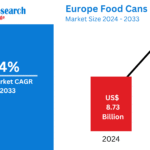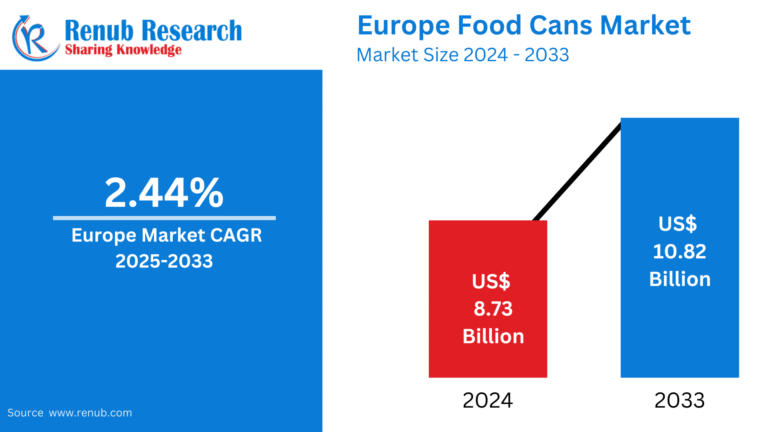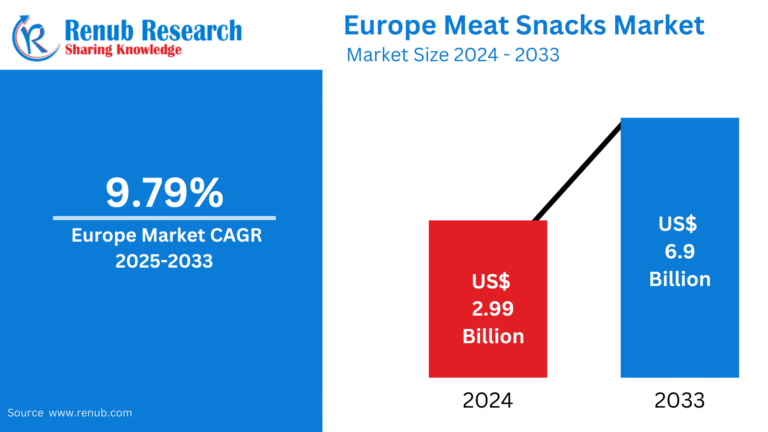📢 Global Frozen Vegetables Market to Surpass USD 55.94 Billion by 2033, Driven by Demand for Convenient and Nutritious Foods – Renub Research
According to Renub Research’s latest report, the Global Frozen Vegetables Market was valued at USD 35.94 billion in 2024 and is forecast to grow at a CAGR of 5.04% from 2025 to 2033, reaching USD 55.94 billion by 2033. The market is experiencing robust growth owing to rising urbanization, fast-paced lifestyles, and increasing consumer preference for healthy, easy-to-prepare meals.
📈 Market Overview: A Revolution in Ready-to-Use Nutrition
Frozen vegetables are rapidly becoming a staple in modern diets. These vegetables are picked at peak ripeness and flash-frozen to lock in nutrients, taste, and freshness, offering consumers year-round availability and minimal food prep time. This has made frozen vegetables a go-to choice for health-conscious, time-strapped consumers globally.
From peas, corn, and spinach to broccoli, mushrooms, and green beans, frozen vegetables are used in a wide variety of cuisines and offer an economical, long-lasting alternative to fresh produce.
🔍 Key Market Trends Driving Growth
1. Demand for Convenience Foods:
In today’s on-the-go world, frozen vegetables offer a perfect balance of nutrition and convenience. With more consumers facing time constraints, frozen vegetables are a quick, mess-free, and nutritious choice. Advanced freezing technologies ensure extended shelf life without compromising quality.
2. Innovation in Product & Packaging:
Food companies are launching new vegetable blends, seasoned options, and resealable, portion-controlled packaging. These innovations cater to evolving consumer preferences and increase brand loyalty.
3. Rising Female Workforce Participation:
The growth of the female workforce, especially in urban centers, is creating demand for efficient meal solutions. Frozen vegetables cater perfectly to this demographic seeking quick yet healthy food options.
4. Expansion in Retail Channels:
Retail innovation is helping frozen vegetables reach more consumers. Availability in discounters, supermarkets/hypermarkets, and online platforms has significantly expanded, helping brands boost visibility and accessibility.
⚠️ Market Challenges
Supply Chain & Storage Issues:
Frozen vegetables require a continuous cold chain, and any disruption can lead to spoilage and financial losses. Additionally, the cost of refrigerated transport and infrastructure remains a concern for producers and distributors.
Consumer Misconceptions:
Despite being nutrient-rich, frozen vegetables often suffer from a perception problem. Some consumers mistakenly view them as inferior to fresh produce, underestimating their nutritional value and convenience.
🌍 Regional Insights
🇺🇸 United States:
With strong agricultural output and advanced freezing infrastructure, the U.S. leads the global frozen vegetable market. In 2023, vegetable production reached 758 million cwt, with tomatoes, onions, and sweet corn leading.
🇫🇷 France:
Changing dietary habits and increasing health awareness have fueled the French frozen vegetable market. Modern freezing technologies and wide retail access are helping to boost sales, especially of organic and mixed blends.
🇮🇳 India:
Urbanization, increased disposable income, and the shift towards convenience foods have catalyzed India’s frozen vegetable growth. Recent launches like Precia by BigBasket and Sanjeev Kapoor aim to capture online demand, targeting ₹100 crore in sales by 2026.
🇸🇦 Saudi Arabia:
Busy lifestyles and growing health consciousness have increased the demand for frozen vegetables in Saudi Arabia. Local players like Siwar Foods are launching ready-to-eat frozen meals, capitalizing on government food security initiatives.
🏢 Competitive Landscape: Major Industry Players
Leading companies in the global frozen vegetables market are:
- General Mills Inc.
- Conagra Brands
- Hormel Foods
- Unilever PLC
- The Kraft Heinz Company
- Nomad Foods Ltd
- B&G Foods, Inc.
- Greenyard
📌 Recent Developments:
- Twin City Foods and Smith Frozen Foods agreed to merge under TCF Holdings, Inc. in Feb 2024.
- No Meat Factory acquired a former Twin City Foods processing plant in Washington for USD 19.4 million to expand plant-based offerings.
📊 Market Segmentation:
By Product:
- Corn, Asparagus, Spinach, Green Peas, Broccoli, Mushroom, Green Beans, Others
By End User:
- Food Service Industry, Retail Customers
By Distribution Channel:
- Discounters, Supermarket/Hypermarket, Others
By Region:
- North America: United States, Canada
- Europe: France, Germany, Italy, Spain, UK, Belgium, Netherlands, Turkey
- Asia Pacific: China, Japan, India, South Korea, Thailand, Malaysia, Indonesia, Australia, New Zealand
- Latin America: Brazil, Mexico, Argentina
- Middle East & Africa: Saudi Arabia, UAE, South Africa
New Publish Reports
- United States Frozen Food Market Size and Share Analysis – Growth Trends and Forecast Report 2025-2033
- North America Frozen and Canned Seafood Market Size and Share Analysis – Growth Trends and Forecast Report 2025-2033
- Global Frozen Food Market Size and Share Analysis – Growth Trends and Forecast Report 2025-2033
❄️ Frequently Asked Questions (FAQs) – Frozen Vegetables Market
Q1. What is the current size of the global frozen vegetables market?
As of 2024, the global frozen vegetables market is valued at US$ 35.94 billion, according to Renub Research.
Q2. What is the projected growth rate of the frozen vegetables market?
The market is expected to grow at a CAGR of 5.04% from 2025 to 2033, reaching US$ 55.94 billion by 2033.
Q3. Which factors are driving the growth of the frozen vegetables market?
Key growth drivers include:
- Increasing demand for convenient and nutritious food
- Urbanization and fast-paced lifestyles
- Rising female workforce participation
- Advancements in freezing technology
- Expanding retail and e-commerce channels
Q4. What are the major product types in the frozen vegetables market?
Popular frozen vegetable categories include:
- Corn
- Asparagus
- Spinach
- Green Peas
- Broccoli
- Mushrooms
- Green Beans
Q5. Who are the primary end-users of frozen vegetables?
The market serves two major end-user segments:
- Food Service Industry (restaurants, hotels, catering)
- Retail Customers (households, online buyers)
Q6. Which distribution channels are most common for frozen vegetables?
Frozen vegetables are widely sold through:
- Supermarkets/Hypermarkets
- Discounters
- Online Retail & Others
Q7. What regions are leading the frozen vegetables market?
Major regional markets include:
- North America (United States, Canada)
- Europe (France, Germany, UK, etc.)
- Asia-Pacific (India, China, Japan, etc.)
- Middle East & Africa (Saudi Arabia, South Africa, UAE)
Q8. What challenges does the frozen vegetables industry face?
- Supply chain disruptions & cold storage costs
- Consumer misconceptions about nutritional value
- Preference for fresh and organic produce in some regions
Q9. Which companies are key players in the frozen vegetables market?
Leading brands include:
- General Mills Inc.
- Conagra Brands
- Unilever PLC
- Hormel Foods
- The Kraft Heinz Company
- Nomad Foods Ltd
- Greenyard
- B&G Foods, Inc.
Q10. Are frozen vegetables as healthy as fresh vegetables?
Yes, frozen vegetables often retain comparable nutrients as fresh ones due to flash-freezing techniques that lock in vitamins, minerals, and freshness at the peak of harvest.
🔍 Report Details:
| Feature | Details |
| Base Year | 2024 |
| Forecast Period | 2025 – 2033 |
| Historical Data | 2020 – 2024 |
| Market Size (2024) | USD 35.94 Billion |
| Market Size (2033) | USD 55.94 Billion |
| CAGR (2025-2033) | 5.04% |
📥 For more information or to purchase the report, please visit www.renub.com
Media Contact:
Renub Research
Email: info@renub.com
Phone: +1-678-302-0700



















